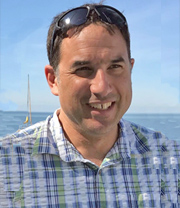
Biography:
The remote sensing of aerosols and clouds; algorithm development for cloud products across low-Earth and geostationary platforms; the production of aerosol and cloud products for operational applications; the development of post-mission data visualizations and products for NASA field campaigns and algorithms and applications for active lidar measurements of the atmosphere.
Although composed of different elements, aerosols (airborne particles originating from fires, exposed soils, breaking waves, natural biological activity, fuel combustion, and other sources) and clouds (masses of water drops or ice crystals) have much in common. Besides being airborne, both aerosol and cloud particles absorb and scatter both sunlight and solar radiation, which can affect weather and climate by impacting Earth's energy balance, surface temperature, and even Earth's water cycle. Further, because they can have a significant effect on climate and weather thousands of miles from where they originated, atmospheric scientists, meteorologists, and environmental scientists routinely observe and monitor both by satellite. Yet, detecting and distinguishing aerosol and cloud particles in satellite observations is not always easy, as the particles that form aerosols and clouds don't always behave or look as expected. Low clouds and fog can exist at ground level and aerosols from volcanic eruptions can be found in the stratosphere. Similarly, in regard to particle concentrations, normally wispy smoke can be so thick it blocks out the Sun while clouds formed of ice crystals can be so sparse that they're practically invisible. This means that the algorithms designed to transform the raw satellite-derived aerosol and cloud data into usable assessments of aerosol optical thickness, cloud cover, or other aerosol- and cloud-related properties have to be as refined and accurate as possible.
Among the scientists working to ensure that the algorithms and data products that meteorologists and atmospheric scientists rely on meet the highest standards is Dr. Robert Holz, Senior Scientist at the University of Wisconsin-Madison's Space Science and Engineering Center. Dr. Holz leads a research group within SSEC that focuses on the remote sensing of aerosols and clouds, including both algorithm development and applications. Cloud algorithm development is based on decades of collaborations with NASA Goddard Space Flight Center personnel who have worked on cloud retrieval from the Moderate Resolution Imaging Spectroradiometer instruments aboard NASA's Aqua and Terra satellites."
In addition to his position with the SSEC, Dr. Holz is also NASA's VIIRS Atmosphere Discipline Lead, a member of the Atmospheric Science Data Center (ASDC) User Working Group (UWG), and co-chair of the Level-1 and Atmosphere Archive and Distribution System Distributed Active Archive Center.

